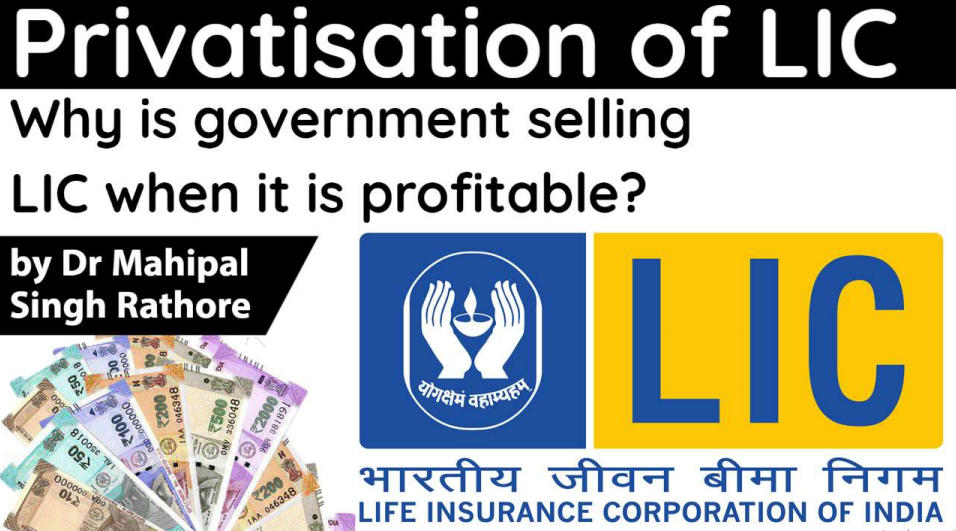Table of Contents
- Finance Minister Nirmala Sitharaman announced in her Budget 2020 speech that the government will sell a part of its holding in Life Insurance Corporation of India (LIC) through an initial public offering (IPO)
- The Parliament of India passed the Life Insurance of India Act on 19 June 1956 creating the Life Insurance Corporation of India, which started operating in September of that year.
- It consolidated the business of 245 private life insurers and other entities offering life insurance services

India’s largest financial institution
- LIC has total assets of 31 trillion rupees (~31 lakh crore OR $434 billion)
- LIC has 1,11,979 employees and ~12 lakh agents
- Profit of Rs 48,444 crore for FY2018
- 76% market share in Insurance sector
- Monopoly till 2000
What sets the LIC apart from other insurers?
- The government owns 100% of LIC
- It is the only insurer offering sovereign guarantee meaning that the policyholders funds are completely secure
- This is the reason that LIC policy premiums are higher than private sector counterparts
What is an IPO?
- An initial public offering (IPO) refers to the process of offering shares of a private* corporation to the public in a new stock issuance
- Public share issuance allows a company to raise capital from public investors
- LIC’s stake sale is likely to be under 10%
Possible delays
- LIC was set up under a special act in 1956
- Hence the government will have to amend the law, a process that may delay the sale beyond March 2021
- An inter-ministerial committee will be set up to decide on the roadmap and extent of disinvestment
- Target is to bring the IPO by second half of FY 2020-21
Aggressive disinvestment
- The govt has targeted an aggressive disinvestment programme
- The government has set an ambitious target of ₹2.1 trillion(2.1 lakh crore) for the sale of government holding in state-run companies
- It includes ₹90,000 crore to be raised from an IPO in LIC and a stake sale in IDBI Bank
- The aggressive stake sale plan comes against the backdrop of declining tax collections and a sharp deceleration in the economy
Why haven’t the earlier governments done so (sold stake in LIC)?
- LIC has been used as an investor of last resort in the past to support the markets by buying shares of state-run companies
- It also bought shares of state-owned companies during divestment and when investor participation was weak.($1.4 billion in ONGC IPO)
- It was also called in to bail out IDBI Bank, which had been severely hit because of bad loans in 2018.(~10,000 crore)
- LIC invests Rs 55,000 crore to Rs 65,000 crore in stock markets every year and emerges as the largest investor in Indian stocks.
- In FY19, LIC invested around Rs 68,620 crore into the equity market.
- It also provides funding for many infrastructure projects – Rs 3,76,097 crore as of March 2018.
Largest Indian Company?
- LIC owns double-digit stakes in several publicly traded firms, including Bharat Heavy Electricals Ltd. and Larsen & Toubro Ltd., that are collectively worth more than $80 billion.
- If LIC shares are listed on stock exchanges, it could easily emerge as the country’s top listed company in terms of market valuation

World’s largest company
- Saudi Aramco, Saudi Arabia’s state owned oil company brought its IPO in December 019
- It raised about $30 billion in the world’s biggest-ever initial public offering
- It soon overtook Microsoft Corp. and Apple Inc. as the most valuable listed company
Benefits of LIC going public
- The government is expecting over ₹70,000 crore from the sale of an undisclosed stake in LIC.
- Listing of companies on stock exchanges disciplines a company and provides access to financial markets and unlocks its value.
- It also gives opportunity for retail investors to participate in the wealth so created.
- Unlike unit-linked insurance plan (Ulip) investors, who have a clear visibility on the daily performance of underlying funds, the endowment policyholders’ visibility is limited to annually declared bonuses
- Public listing of LIC will lead to more disclosures of investment and loan portfolios and better governance, with greater transparency and accountability.
- Listing will allow analysts to monitor LIC’s governance.
- LIC will come under Sebi’s direct watch and will have to comply with the requirements meant for other listed firms
- Such compliance is likely to strengthen its overall corporate governance, financial and investment discipline
- Over time, this will increase its efficiency and it may deliver higher returns to policyholders
- Government’s influence on its asset management will reduce
Latest Burning Issues | Free PDF






















 WhatsApp
WhatsApp